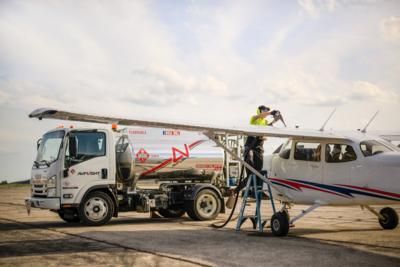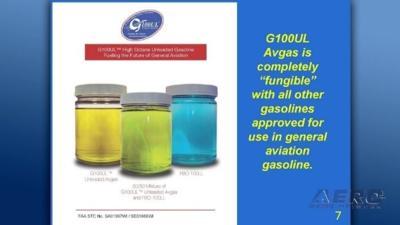First Step In A... 'Process That Will Most Likely Conclude With The Eventual Removal Of Lead From Avgas'
EAA notes that, 'On Friday, October 7, the Environmental Protection Agency (EPA) released its long-awaited proposed finding of endangerment regarding lead emissions from piston aircraft.

This was not unexpected and is the first step in a multi-year, multi-step regulatory process that will most likely conclude with the eventual removal of lead from avgas.'
The general aviation community remains committed to removing lead from aviation gasoline by the end of 2030, without compromising the safe and efficient operation of the fleet and the economic health of the general aviation community. Therefore our industry has joined with the Federal Aviation Administration (FAA) in the Eliminate Aviation Gasoline Lead Emissions (EAGLE) initiative, which provides for an orderly and safe transition to a lead-free avgas future.
Near Term Impacts
The EPA notice does not change the current production, distribution, sale, or use of 100 low-lead (100LL) fuel. A primary tenet of EAGLE is to ensure that 100LL remains available for the safe operation of the current fleet as the community transitions to unleaded fuel.

General aviation’s continued use of leaded avgas through the transition period will likely attract opposition and result in growing pressure on airports and operators at the state and local levels. In addition, more airports face challenges from local anti-airport activists looking to close or significantly reduce operations. The EPA announcement will undoubtedly be used by those groups.
Fortunately, EAA members and chapters have a remarkable history of bridging the gap between airports and their surrounding communities. Events such as Young Eagles, fly-ins, and open houses, most of which welcome the public, have formed strong bonds between pilots and locals. Airport managers, pilots, and aircraft owners will rely on these long-standing relationships to educate communities about plans to transition to unleaded fuels by 2030. Our goal is to avoid a patchwork of airport-specific requirements leading to inconsistent fuel availability. That could create a situation where aircraft could be mis-fueled, leading to safety and operational concerns.
Next Steps
The EPA, FAA, and aviation community are ultimately working toward the same goal: a fleet-wide transition to an unleaded fuel by the end of 2030. There are already promising steps taken in that direction and more to come in the near future.

With something as complex and safety-related as changing the fuel for the entire general aviation fleet, the FAA and industry will move cautiously and methodically toward a safe and effective transition to any unleaded replacement.
Currently, the FAA does not regulate avgas because the FAA has no authority to regulate fuels. Standards for the refining, blending, and distribution of avgas are developed and administered by the petroleum and aviation industries through consensus standards administered by organizations such as ASTM International. Ultimately, the “ban” on leaded avgas might take the form of an operating rule under Part 91 for instance, simply stating that on a particular date, no aircraft may use fuels containing lead.
It’s important to note that lead cannot be removed or “banned” from avgas by the EPA or FAA until all of these regulatory steps prescribed under the Clean Air Act are taken - likely not for a number of years.
On September 1, the FAA issued supplemental type certificates to allow General Aviation Modifications Inc.’s (GAMI) 100-octane unleaded fuel (G100UL) to be reportedly used in every spark-ignition engine and every airframe powered by those engines. The deployment of this fuel and its adoption by general aviation will help guide the EPA and FAA’s regulatory efforts.
In addition to GAMI, three high-octane unleaded fuels continue to be evaluated. Swift Fuels is working through the FAA Supplemental Type Certification process while Afton/Phillips 66 and Lyondell/VP Racing are using the EAGLE fleet authorization process. The outcomes of these efforts will also be considered in the EPA and FAA rulemaking activities and any unleaded fuel transition.
Rulemaking Steps
Step 1: EPA’s Endangerment Finding. Under the Clean Air Act, the EPA has the authority to find that a particular air pollutant emitted from aircraft engines “causes, or contributes to, air pollution which may reasonably be anticipated to endanger public health or welfare.” This process involves studying the pollutant in question, its sources and quantities, then publishing a proposed finding (which is where we are currently), followed by public comment and a potential final finding of endangerment.

As stated on EPA’s website, “After evaluating comments on the proposal, we plan to issue any final endangerment finding in 2023.” It should be noted that a final finding could be either endangerment or non-endangerment. Assuming the final finding in 2023 concludes that lead emissions from piston engine aircraft does cause, or contribute to, air pollution which may reasonably be anticipated to endanger public health or welfare (otherwise known as a positive endangerment finding), EPA then moves to a regulatory action in step 2a below.
On the cusp of EPA’s positive endangerment finding the FAA has an obligation to “prescribe standards for the composition or chemical or physical properties of an aircraft fuel or fuel additive” as described in step 2b below. The EPA and FAA steps outlined in 2a and 2b below will most likely occur concurrently.

Step 2a: EPA’s Aircraft Emissions Standards. Once the EPA determines that a pollutant endangers public health or welfare, it triggers a statutory requirement under the Clean Air Act to propose engine emission standards to address the issue. The EPA must consult with the FAA to consider technology, safety, and noise when establishing aircraft engine emission standards. The development of these standards will entail another proposed and final rulemaking allowing for public comment and input. It is reasonable to expect this process to take approximately two years as there are no lead emission standards currently in place.
It is also important for the aviation community to understand, that per the Federal code as passed by Congress, EPA’s aircraft emission standards cannot “adversely affect safety.”
Step 2b: FAA’s Fuel Standards. Following a positive endangerment finding by the EPA for lead emissions from aircraft piston engines, the FAA is obligated to regulate it both as a fuel component and as a fuel additive. Generally, this would be another rulemaking process that would take the usual rulemaking steps lasting approximately two years.

Step 3: FAA’s Certification Standards. Once EPA has promulgated lead emissions standards for piston-engine aircraft, the FAA is responsible for enforcing EPA regulations. This is yet another multi-year process involving proposed rulemaking, public comment, and internal government coordination. The publication of a final rule does not in and of itself implement an immediate “ban” on the use of leaded avgas.
EAA’s primary mission through all of this is to ensure a smart and safe transition to an unleaded fuel that preserves the utility of the existing general aviation fleet and maintains a stable and cost-effective supply of fuel now and into the future.
 ANN's Daily Aero-Term (04.26.24): DETRESFA (Distress Phrase)
ANN's Daily Aero-Term (04.26.24): DETRESFA (Distress Phrase) ANN's Daily Aero-Linx (04.26.24)
ANN's Daily Aero-Linx (04.26.24) Airborne 04.22.24: Rotor X Worsens, Airport Fees 4 FNB?, USMC Drone Pilot
Airborne 04.22.24: Rotor X Worsens, Airport Fees 4 FNB?, USMC Drone Pilot Airborne 04.24.24: INTEGRAL E, Elixir USA, M700 RVSM
Airborne 04.24.24: INTEGRAL E, Elixir USA, M700 RVSM Airborne-NextGen 04.23.24: UAVOS UVH 170, magni650 Engine, World eVTOL Directory
Airborne-NextGen 04.23.24: UAVOS UVH 170, magni650 Engine, World eVTOL Directory








